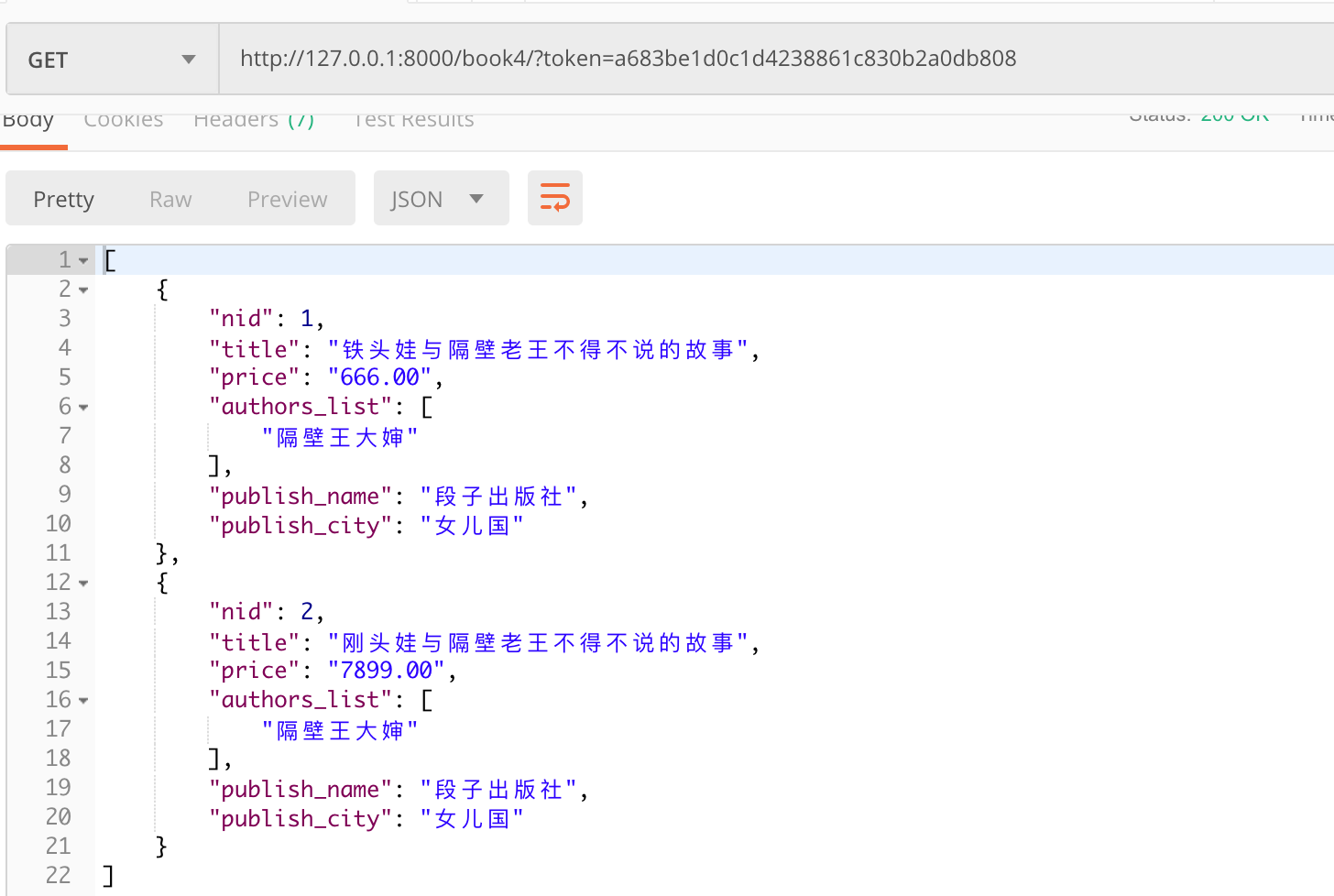04-节流(访问限制)
一.自定义节流
限制单个IP60秒只能访问3次
1.节流器是单个组件,独立放在utils目录中
utils/throttle.py
from rest_framework.throttling import BaseThrottle import time VISIT_RECORD = {} # 保存访问记录 class VisitThrottle(BaseThrottle): def __init__(self): self.history = None # 初始化访问记录 def allow_request(self, request, view): # 获取用户IP remote_addr = self.get_ident(request) ctime = time.time() if remote_addr not in VISIT_RECORD: VISIT_RECORD[remote_addr] = [ctime, ] return True # 表示可以访问 # 获取当前ip的历史访问记录 history = VISIT_RECORD.get(remote_addr) # 初始化访问记录 self.history = history # 如果有历史访问记录,并最早一次访问记录离当前记录超过60S,就删除最早的那个访问记录, while history and history[-1] < ctime - 60: history.pop() # 如果访问不操过三次,就把当前访问记录插入到第一个位置 if len(history) < 3: history.insert(0, ctime) return True def wait(self): """ 还需要等多久才能访问 :return: """ ctime = time.time() return 60 - (ctime - self.history[-1])
2.在setting中配置全局节流
REST_FRAMEWORK = { # 节流 "DEFAULT_THROTTLE_CLASSES": ['utils.throttle.VisitThrottle'], }
3.看看访问结果
- 60S之类访问次数超过3次,限制访问
- 提示多少秒后能访问
正常访问

访问被限制,提示多少秒后能访问

2.节流源码简析
1.所有的drf功能都是基于APIView实现的,看下dispatch方法
APIView.dispatch
def dispatch(self, request, *args, **kwargs): """ `.dispatch()` is pretty much the same as Django's regular dispatch, but with extra hooks for startup, finalize, and exception handling. """ self.args = args self.kwargs = kwargs # 对原始request进行再次封装,增加一些drf的功能 # Request( # request, # parsers=self.get_parsers(), 解析器 # authenticators=self.get_authenticators(), 认证 # negotiator=self.get_content_negotiator(), # parser_context=parser_context # ) # request(原始request,[BasicAuthentications对象,]) # 获取原生request,request._request # 获取认证类的对象,request.authticators # 1.封装request request = self.initialize_request(request, *args, **kwargs) self.request = request self.headers = self.default_response_headers # deprecate? try: # 2.认证,权限,节流触发 self.initial(request, *args, **kwargs) # Get the appropriate handler method if request.method.lower() in self.http_method_names: handler = getattr(self, request.method.lower(), self.http_method_not_allowed) else: handler = self.http_method_not_allowed response = handler(request, *args, **kwargs) except Exception as exc: response = self.handle_exception(exc) self.response = self.finalize_response(request, response, *args, **kwargs) return self.response
2.APIView.initial
def initial(self, request, *args, **kwargs): """ Runs anything that needs to occur prior to calling the method handler. """ self.format_kwarg = self.get_format_suffix(**kwargs) # Perform content negotiation and store the accepted info on the request neg = self.perform_content_negotiation(request) request.accepted_renderer, request.accepted_media_type = neg # Determine the API version, if versioning is in use. version, scheme = self.determine_version(request, *args, **kwargs) request.version, request.versioning_scheme = version, scheme # Ensure that the incoming request is permitted # 3.认证 self.perform_authentication(request) # 4.权限 self.check_permissions(request) # 5.节流 self.check_throttles(request)
3.APIView.check_throttles
def check_throttles(self, request): """ Check if request should be throttled. Raises an appropriate exception if the request is throttled. """ # 6.get_throttles 获取节流器 for throttle in self.get_throttles(): if not throttle.allow_request(request, self): self.throttled(request, throttle.wait())
4.APIView.get_throttles
def get_throttles(self): """ Instantiates and returns the list of throttles that this view uses. """ # 7返回所有的节流器 return [throttle() for throttle in self.throttle_classes]
5.throttle_class
class APIView(View): # The following policies may be set at either globally, or per-view. renderer_classes = api_settings.DEFAULT_RENDERER_CLASSES parser_classes = api_settings.DEFAULT_PARSER_CLASSES authentication_classes = api_settings.DEFAULT_AUTHENTICATION_CLASSES throttle_classes = api_settings.DEFAULT_THROTTLE_CLASSES # 读取配置中的节流器 permission_classes = api_settings.DEFAULT_PERMISSION_CLASSES content_negotiation_class = api_settings.DEFAULT_CONTENT_NEGOTIATION_CLASS metadata_class = api_settings.DEFAULT_METADATA_CLASS versioning_class = api_settings.DEFAULT_VERSIONING_CLASS
6.api_settings
api_settings = APISettings(None, DEFAULTS, IMPORT_STRINGS) #
@property def user_settings(self): if not hasattr(self, '_user_settings'): self._user_settings = getattr(settings, 'REST_FRAMEWORK', {}) # 读取用户setting中的配置 return self._user_settings def __getattr__(self, attr): if attr not in self.defaults: raise AttributeError("Invalid API setting: '%s'" % attr) try: # Check if present in user settings val = self.user_settings[attr] except KeyError: # Fall back to defaults val = self.defaults[attr] # Coerce import strings into classes if attr in self.import_strings: val = perform_import(val, attr) # 动态import用户自定义的节流类 # Cache the result self._cached_attrs.add(attr) setattr(self, attr, val) return val
7.throttle.allow_request(request,self)
for throttle in self.get_throttles(): # throttle.allow_request(request, self) 节流逻辑,返回bool,返回Fales触发throttled节流,,如果自定义节流类需要重新改方法和wait方法 if not throttle.allow_request(request, self): self.throttled(request, throttle.wait())
三.drf自带的节流器
上面写了一个自定义节流器,助于我们理解源码,drf内置了几个节流器,用起来比较简单方便
1.BaseThrottle类,
自己需要重写allow_request和wait方法
get_ident 获取IP地址
class BaseThrottle(object): """ Rate throttling of requests. """ # 节流逻辑,基础该类需要重写该方法 def allow_request(self, request, view): """ Return `True` if the request should be allowed, `False` otherwise. """ raise NotImplementedError('.allow_request() must be overridden') # 获取远程IP地址 def get_ident(self, request): """ Identify the machine making the request by parsing HTTP_X_FORWARDED_FOR if present and number of proxies is > 0. If not use all of HTTP_X_FORWARDED_FOR if it is available, if not use REMOTE_ADDR. """ xff = request.META.get('HTTP_X_FORWARDED_FOR') remote_addr = request.META.get('REMOTE_ADDR') num_proxies = api_settings.NUM_PROXIES if num_proxies is not None: if num_proxies == 0 or xff is None: return remote_addr addrs = xff.split(',') client_addr = addrs[-min(num_proxies, len(addrs))] return client_addr.strip() return ''.join(xff.split()) if xff else remote_addr # 触发节流器后给予用户的提示,需要重写 def wait(self): """ Optionally, return a recommended number of seconds to wait before the next request. """ return None
2.SimpleRateThrottle类
我们可以通过继承SimpleRateThrottle类,来实现节流,会更加的简单,因为SimpleRateThrottle里面都帮我们写好了
class VisitThrottle(SimpleRateThrottle): scope = 'anonymous' # 这里面的值,自己随便定义,settings里面根据这个值配置Rate def get_cache_key(self, request, view): # 通过IP标识节流 return self.get_ident(request) class UserThrottle(SimpleRateThrottle): scope = 'auth_user' def get_cache_key(self, request, view): # 验证用户通过用户名标示计数节流 return request.user.username
settings,全局节流
REST_FRAMEWORK = { # 节流 "DEFAULT_THROTTLE_CLASSES": ['utils.throttle.VisitThrottle'], "DEFAULT_THROTTLE_RATES": { # 匿名用户 'anonymous': '3/m', # 登录用户 'auth_user': '10/m' } }
views.py
局部节流
class Login(APIView): # 登录路由,非认证用户,节流3/m throttle_classes = [VisitThrottle] def post(self, request): response = dict() fields = {'username', 'password'} user_info = dict() if fields.issubset(set(request.data)): for key in fields: user_info[key] = request.data[key] user_instance = authenticate(**user_info) if user_instance is not None: access_token = generate_token() UserToken.objects.update_or_create(user=user_instance, defaults={'token': access_token}) response['status_code'] = 200 response['status_message'] = '登录成功' response['access_token'] = access_token response['user_role'] = user_instance.get_user_level_display() else: response['status_code'] = 201 response['status_message'] = '用户名或密码错误' return Response(response)
class BookView(ModelViewSet): authentication_classes = [UserAuth] permission_classes = [UserPermission] # 登录用户节流,10/m throttle_classes = [UserThrottle] queryset = Book.objects.all() serializer_class = BookSerialize
说明:
- utils.throttle.UserThrottle 这个是全局配置(根据ip限制,10/m)
- DEFAULT_THROTTLE_RATES --->>>设置访问频率的
- throttle_classes = [VisitThrottle,] --->>>局部配置(不适用settings里面默认的全局配置)
总结
基本使用
- 创建类,继承BaseThrottle, 实现:allow_request ,wait
- 创建类,继承SimpleRateThrottle, 实现: get_cache_key, scope='auth_user' (配置文件中的key)



 浙公网安备 33010602011771号
浙公网安备 33010602011771号